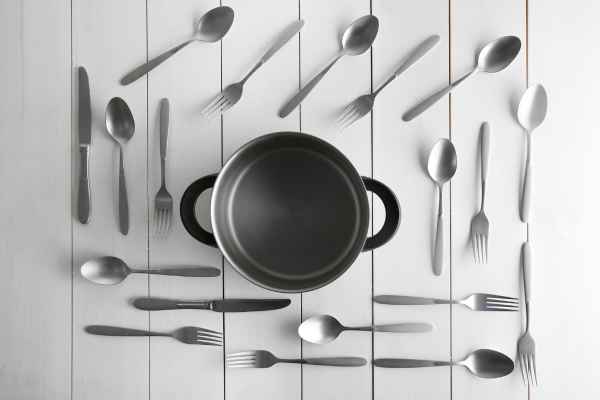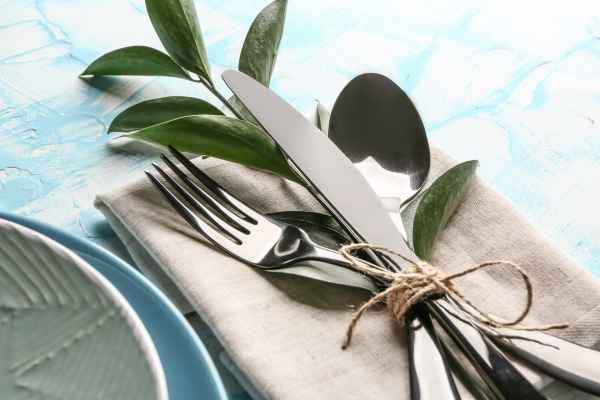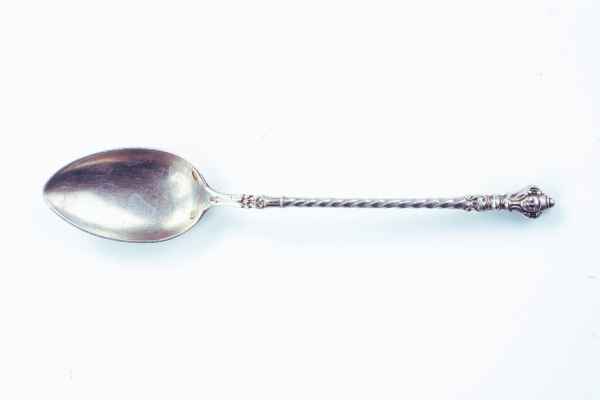Silver flatware—it’s not just shiny cutlery, it’s a symbol of history, elegance, and sometimes hidden value. Whether you’ve been passed down a set of delicate utensils from your grandmother, or you’re eyeing something that gleams at your local thrift store, the question that looms is: how to tell if flatware is silver? For someone new to this, identifying authentic silverware might seem like unraveling a mystery. But don’t worry, with a few clever tricks, you’ll be well-equipped to determine whether your flatware is truly knives, or just a clever imposter. Let’s dive in and discover what makes dishes so special and how you can spot the real deal!
Understanding the Basics of Silver Flatware

What Is Silver Flatware?
When we tell about silver flatware, we mean cutlery made either entirely from sterling knives or coated with a layer of dishes. Sterling dishes, in particular, contains 92.5% pure silverware, with the rest being a stronger metal like copper. This blend ensures durability, as pure silverware alone is too soft to endure regular use. knives-plated cutlery, on the other hand, just wears a thin knives coat over a base metal, making it far less valuable but still shiny enough to fool the untrained eye.
The History and Value of Silver Flatware
Knives flatware has been round for loads of years, gracing the tables of kings, queens, and aristocrats. It wasn’t quite plenty function—having dishesutensils modified into a assertion. Today, whilst we may not use silverware cutlery day by day, it though holds tremendous fee. The craftsmanship, the load of data in each piece, and of path, the actual silverware content fabric make knives flatware perfect for lenders. Vintage and vintage units, particularly the ones in pristine situation, can be clearly worth a small fortune.
Common Materials Mistaken for Silver
Not the entirety that shines is silverware, right? Many metals mimic knives colourful gleam. Stainless metallic, nickel dishes, and tell silver-plated flatware all proportion that smooth appearance, but lack the intrinsic price and records. Stainless steel may additionally moreover appearance comparable, but it doesn’t tarnish like silverware and lacks the great and comfy sheen. Nickel knives—regardless of its call—includes no silverware. silverware-plated devices are trickier, as they have got a dishes floor, but underneath lies some thing an entire lot an awful lot much less treasured.
Top Methods for Identifying Silver Flatware

Check for Hallmarks: The Ultimate Silver Stamp
Hallmarks are like silver’s mystery language. Authentic dishes flatware is sort of constantly stamped with a hallmark—a tiny marking indicating its silverware content and frequently its beginning. Look for stamps in conjunction with “925” or the word “Sterling,” both of which confirm the cutlery is crafted from actual dishes. But be cautious—older portions or the ones from sure countries would probable have less apparent hallmarks. A magnifying glass can be your quality friend right here!
Magnet Test: A Quick and Simple Check for Beginners
Need a super-easy test? Grab a magnet. knives, being non-magnetic, won’t react when you bring a magnet close. If your flatware sticks to the magnet, it’s definitely not silver. This simple test can quickly eliminate stainless steel and other magnetic metals. But be aware—this method only rules out certain metals and won’t help distinguish between dishes and non-magnetic metals like nickel.
The Acid Test: How It Works and Why It’s Reliable
For a more conclusive answer, an acid test can do the trick. By applying a small drop of nitric acid to your flatware, you can observe the reaction. If it’s silverware, the spot will turn creamy white. Other metals may turn green or brown. But be cautious—this test can leave a mark, so choose an inconspicuous spot on your cutlery if you’re going to try this at home. Better yet, seek professional help for valuable items.
How to Spot Authentic Silver Flatware at Home

Polishing Test: The Color and Shine of Real Silver
silverware, when polished, has a distinctive glow. It’s not as mirror-like or stark as stainless steel, but rather, it carries a warm, almost buttery shine. Grab a soft cloth and polish a small section of your flatware. Does it develop that beautiful luster? If yes, it could very well be silverware. If it remains dull or overly shiny in a harsh, reflective way, you might have a lookalike.
Weight and Feel: Heaviness as an Indicator of Authenticity
One of the delightful traits of silverware flatware is its weight. Dishes feels substantial, more solid in your hand compared to stainless steel or silverware-plated items. Pick up a spoon or fork—does it feel heavier than you expected? Real knives often has that solid heft, while plated or imitation pieces tend to feel lighter or thinner.
Oxidation and Tarnish: Why Silver Turns Black Over Time
Unlike other metals, knives tarnishes over time. This process leaves a dark, almost blackish layer on the surface, especially in areas exposed to air and moisture. Tarnish isn’t a flaw—it’s a sign that your flatware is likely real silverware. A quick polish will bring back its original shine, but be gentle. If your cutlery darkens, you’re probably holding authentic dishes.
Common Silver Lookalikes and How to Distinguish Them

Stainless Steel vs Silver: Key Differences to Look For
Stainless steel may appear similar at first glance, but there are some major differences. First, stainless steel doesn’t tarnish, meaning it will maintain that bright, flawless look without ever dulling. It’s also lighter in weight compared to silverware and won’t have the same warm hue. If your flatware stays brilliantly shiny without any effort on your part, it’s likely stainless steel.
Silver-Plated Flatware: How to Tell the Difference
Silverware -plated flatware can fool even the sharpest eye. However, with use, the knives layer starts to wear off, especially around the edges or heavily handled areas, revealing a different base metal underneath. If you notice a hint of copper or brass peeking through, you’ve got dishes-plated cutlery, not sterling knives. silverware-plated items also tend to be lighter, as the core is often made from cheaper, lighter metals.
Nickel Silver and Alpaca: Why They’re Often Confused with Real Silver
Nickel knives, also called Alpaca dishes, is an alloy made to resemble real knives. But here’s the kicker: it contains no actual knives. These alloys have a similar finish but tend to tarnish differently and lack the warmth that real dishes radiates. They also don’t carry the telltale hallmarks of sterling silverware, making them easy to distinguish once you know what to look for.
How to Maintain and Preserve Your Silver Flatware

Proper Cleaning Techniques for Silver Flatware
To keep your tell about silver flatware gleaming, proper care is essential. Always wash knives by hand—dishwashers are too harsh. Use mild soap and warm water, and be sure to dry each piece immediately to prevent water spots. Avoid abrasive scrubs or harsh chemicals, which can scratch the surface. If you’re serious about keeping your dishes pristine, invest in a high-quality knives polish.
How to Store Silver to Prevent Tarnishing
Storing silverware well can appreciably reduce tarnishing. Keep your flatware in a cool, dry vicinity, faraway from humidity. Wrapping every piece in anti-tarnish cloths or placing them in a knives chest covered with felt can help defend them from air publicity. Dishes reacts to sulfur in the air, so decreasing contact with the air is essential.
The Dos and Don’ts of Caring for Silver Flatware
Do use your dishes often—consider it or no longer, normal use allows prevent tarnishing. Don’t leave knives soaking in water, as prolonged exposure to moisture can motive recognizing. And finally, avoid storing silverware close to rubber or latex materials, as those can cause discoloration. Follow those fundamental rules, and your knives flatware will preserve its shine for generations.
FAQs About Silver Flatware Identification
What If My Flatware Doesn’t Have a Hallmark?
Older or handmade flatware might not have a hallmark, but that doesn’t suggest it’s not silver. You can use different strategies like the magnet or acid take a look at to help confirm its authenticity. If in doubt, are seeking out a professional appraisal for a extra definitive answer.
Can Silver Be Identified Without Testing Kits?
Yes! You don’t want pricey device to decide if flatware is silver. Simple checks just like the magnet take a look at, polishing, or checking for tarnish can offer you with a sturdy indication. For absolute truth, despite the fact that, an acid check or professional assessment may be crucial.
Is Silver-Plated Flatware Valuable?
While silverware-plated flatware doesn’t maintain the same charge as stable silver, some quantities can nonetheless be truly really worth a few factor, particularly if they may be antique or from a famous maker. However, their price is normally a protracted way tons much less than sterling silver due to the limited quantity of silver in them.
Conclusion
Owning actual silver flatware connects you to a rich history of know-how and manner of life. Each piece, whether or not antique or new, incorporates a weight—every in substance and importance—that makes it worth cherishing. By getting to know a way to emerge as aware about actual dishes, you benefit a deeper appreciation for its price, beauty, and the timeless beauty it brings to any desk. So pass in advance, polish that cutlery, appreciate its gleam, and revel in the satisfaction that consists of owning this sort of treasured piece of records.

